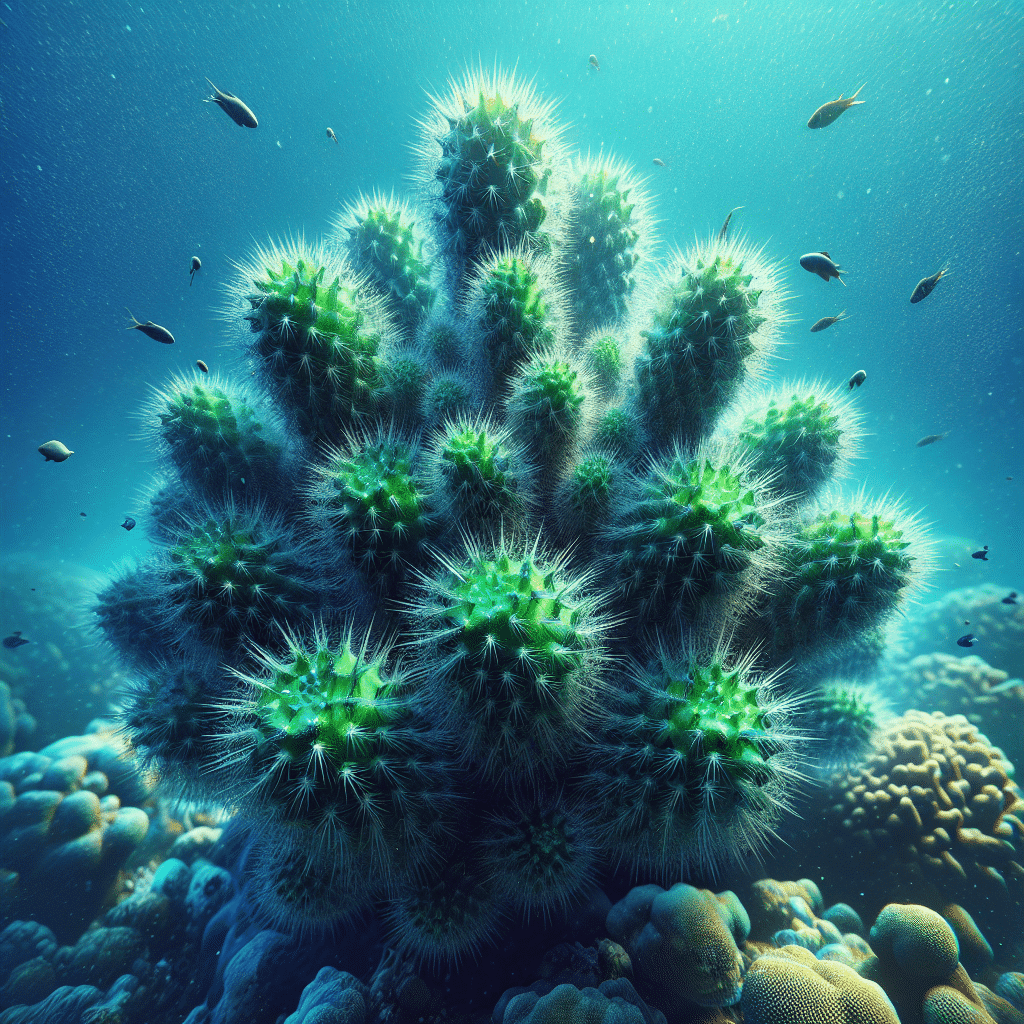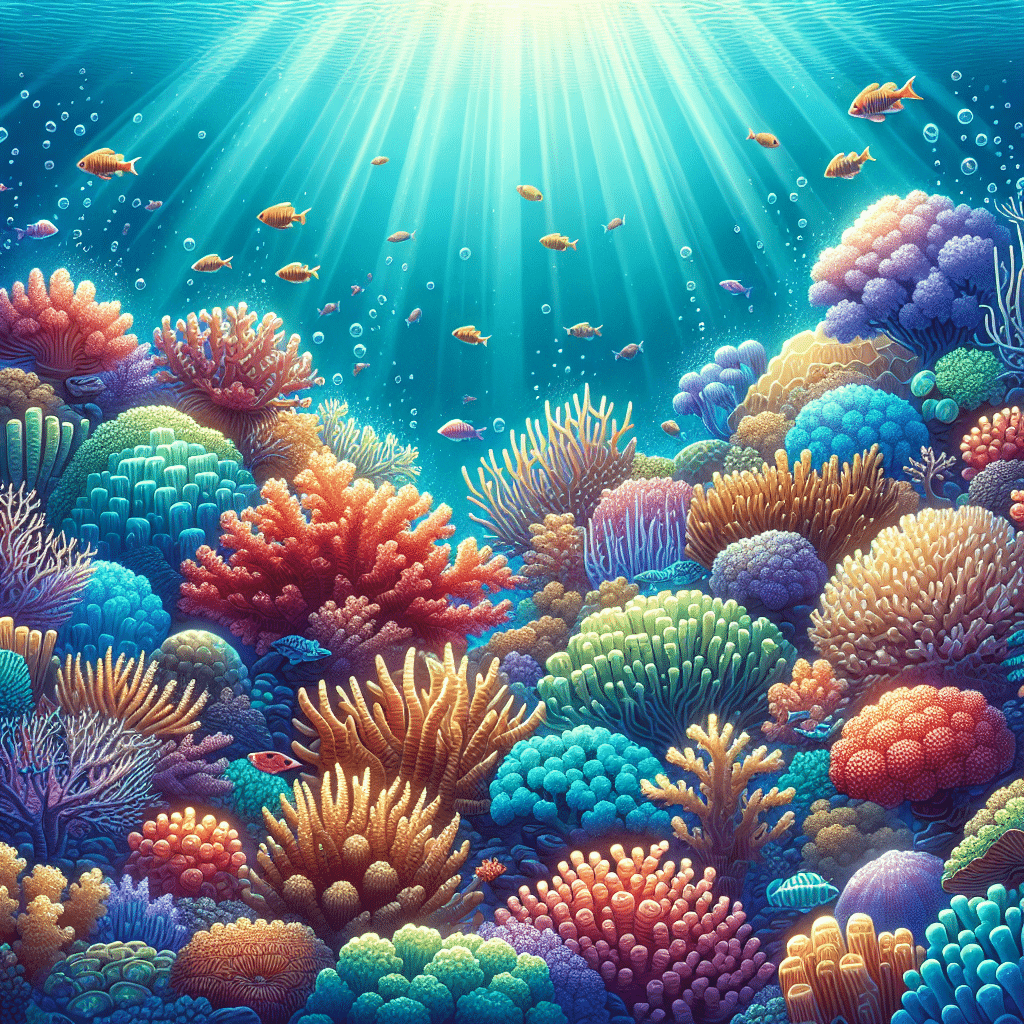Understanding Coral Cactus
Coral Cactus Overview
I find the coral cactus, also known as the Boxing glove cactus or the Sonoran jumping cholla, to be a fascinating succulent. This treelike plant can grow between 1 to 3 meters tall, featuring a woody trunk and cylindrical cladodes. Its light green, spiny stems have a unique charm, making it a popular choice among succulent enthusiasts. The terminal segments of each stem are designed to detach easily, which adds to its quirky nature (Brisbane City Council).
The Cereus ‘Green Coral Cactus’ hails from South America, particularly Brazil and Argentina, and thrives in arid conditions. Its elongated, ribbed stems can grow upright or sprawl out, mimicking coral formations. The vibrant green color and coral-like structure truly make it stand out in any collection (BWH Plant Co).
Coral Cactus Characteristics
What makes coral cactus so unique is that it’s actually a graft of two different succulents. The top, ruffled portion is the crest of Euphorbia lactea, while the green ‘stem’ is Euphorbia neriifolia. This grafting process results in a visually striking plant that requires relatively low maintenance, making it a great houseplant (The Spruce).
When it comes to care, the coral cactus should not be allowed to dry out completely for more than a couple of days. It’s best to water it once the top 2 to 4 inches of soil are dry. During spring and summer, it requires more frequent watering compared to the fall and winter months (The Spruce).
| Characteristic | Description |
|---|---|
| Height | 1-3 meters |
| Stem Type | Cylindrical cladodes |
| Color | Light green |
| Grafting | Euphorbia lactea & Euphorbia neriifolia |
| Watering Needs | Top 2-4 inches of soil dry |
Understanding these characteristics helps me appreciate the coral cactus even more. For anyone interested in adding this unique plant to their collection, knowing its care requirements is key to maintaining its health and beauty.
Coral Cactus Care Guide
Taking care of a cactus coral is pretty straightforward, but there are some key things I’ve learned about watering, light, temperature, fertilizing, and propagation that make a big difference.
Watering and Soil Needs
The coral cactus should not dry out completely for more than a couple of days. I usually water mine once the top 2 to 4 inches of soil are dry. It requires more frequent watering in the spring and summer, while it needs less in the fall and winter. Here’s a quick rundown:
| Season | Watering Frequency |
|---|---|
| Spring | Once a week |
| Summer | Once a week |
| Fall | Every 2 weeks |
| Winter | Every 3 weeks |
Using well-draining soil is crucial. A cactus potting mix is ideal because it allows excess water to escape, preventing root rot.
Light and Temperature Requirements
Coral cactus loves warm, dry conditions. I’ve found that it thrives in bright, indirect light. It’s important to keep it away from direct sunlight, as this can scorch the plant. As for temperature, the coral cactus cannot tolerate temperatures below 60°F. It’s best suited for USDA zones 10 to 11, which means it can be a great indoor houseplant or an outdoor plant in warmer climates.
Fertilizing and Propagation Tips
I’ve learned that the coral cactus is a slow grower, so it benefits from a fertilizer specifically designed for cacti and succulents. I fertilize mine monthly during the spring and summer, but I stop in the fall. Here’s a quick fertilizer schedule:
| Time of Year | Fertilizer Frequency |
|---|---|
| Spring | Monthly |
| Summer | Monthly |
| Fall | None |
| Winter | None |
Propagation can be a bit tricky. The coral cactus can only be propagated by grafting two healthy plants: Euphorbia neriifolia and Euphorbia lactea. Since it can’t be propagated from cuttings or seeds, I find it more practical to just buy a new plant instead of trying to graft one myself.
By following these care tips, I’ve managed to keep my cactus coral healthy and thriving. For more information about corals, check out our section on corals.
Coral Cactus as a Houseplant
Indoor Placement
When it comes to placing my coral cactus indoors, I’ve found that it thrives best in a bright spot with indirect sunlight. Direct sunlight can actually scorch its unique structure, so I usually aim for a location where it can soak up light without being overwhelmed. I like to keep mine near a window that gets filtered light.
It’s also important to keep the temperature in mind. My coral cactus prefers warm, dry conditions and doesn’t do well in temperatures below 60 degrees Fahrenheit. If I live in USDA zones 10 to 11, I can even consider keeping it outside during the warmer months. Just make sure it’s protected from harsh sun and frost.
Maintenance and Growth Expectations
The coral cactus is a slow grower, so patience is key. I usually fertilize it monthly during the spring and summer with a fertilizer designed for cacti and succulents. This gives it the nutrients it needs to thrive. However, I stop fertilizing in the fall as it enters its dormant phase (The Spruce).
Watering is another critical aspect of maintenance. I ensure that the top 2 to 4 inches of soil are dry before watering again. This usually means I water more frequently in the spring and summer and cut back during the fall and winter. It’s crucial not to let it dry out completely for more than a couple of days.
Here’s a quick table to summarize the care needs of the coral cactus:
| Care Aspect | Requirement |
|---|---|
| Light | Bright, indirect sunlight |
| Temperature | Above 60°F (warm, dry conditions) |
| Watering | Once top 2-4 inches of soil are dry |
| Fertilizing | Monthly in spring/summer; none in fall/winter |
By following these guidelines, I can enjoy my coral cactus as a beautiful and unique addition to my home. If I ever feel stuck on how to care for other types of corals, I can always check out more on corals or specific types like brain coral or torch coral.
Threats to Coral Cactus
Invasive Concerns
Coral cactus can be a bit of a troublemaker in natural habitats. It invades grasslands and pastures, competing fiercely with native species for food and space. This not only disrupts local ecosystems but also creates hazards for wildlife. Animals such as reptiles, birds, bats, and small mammals can get impaled on the sharp spines of the coral cactus, often leading to serious injuries or death.
In addition to its invasive nature, the coral cactus is part of a broader concern: cacti, in general, are ranked as the fifth most-threatened group of living organisms in the world. Approximately 31% of the evaluated cactus species face extinction risks, primarily due to illegal trade and poaching.
Conservation Efforts
Given these threats, conservation efforts are crucial. Organizations like the Desert Botanical Garden have taken initiatives to address the declining populations of cacti, including coral cacti. They host the Cactus and Succulent Specialist Group, which aims to lead global conservation efforts. This includes raising awareness about the importance of cacti in ecosystems and advocating against illegal trade practices (Desert Botanical Garden).
Cacti play an essential role in their ecosystems, providing food and shelter for various wildlife. Protecting them ensures that these animals can thrive and that the balance of the ecosystem remains intact. As hobbyists, we can contribute to conservation by sourcing our coral cacti from reputable growers and avoiding illegal trade. For more information on maintaining a thriving reef tank, feel free to explore our articles on various types of corals like brain coral and torch coral.
Significance of Coral Reefs
Ecosystem Importance
Coral reefs are vital to the health of our oceans, providing a habitat for approximately 25% of the world’s marine life. This includes over 4,000 fish species, as well as a variety of invertebrates, mammals, turtles, and algae. They play a crucial role in maintaining biodiversity and supporting marine ecosystems by acting as breeding and feeding grounds.
These vibrant ecosystems are not just bustling underwater cities; they also help mitigate climate change by removing carbon dioxide from the atmosphere. Additionally, coral reefs act as natural breakwaters, reducing the impact of waves and storms on coastlines. This protection is essential for coastal communities, as it helps to prevent erosion and safeguard infrastructure.
The economic value of coral reefs is immense. They not only provide jobs for local communities through fishing and tourism but also offer recreational opportunities. In fact, the net economic value of the world’s coral reefs is estimated to be nearly tens of billions of U.S. dollars per year. Over half a billion people depend on these ecosystems for food, income, and protection.
Threats to Coral Reefs
Despite their importance, coral reefs face numerous threats. Climate change is the most significant danger, leading to coral bleaching events triggered by warmer waters. When corals are stressed from heat, they expel the symbiotic algae (zooxanthellae) that provide them with nutrients and color, which can hinder growth and lead to mass mortality (IFAW).
Other threats include pollution, overfishing, and destructive fishing practices, which can damage the delicate balance of these ecosystems. Coastal development and habitat destruction also pose significant risks to coral reefs, as they can lead to increased sedimentation and reduced water quality.
Addressing these threats is crucial for the survival of coral reefs. Conservation efforts, including protecting marine areas and promoting sustainable fishing practices, are vital to ensuring these ecosystems continue to thrive. For more information on specific types of corals, check out our articles on brain coral, staghorn coral, and mushroom coral.
Coral Reef Conservation
Coral Reef Protection
Protecting coral reefs is essential for maintaining the health of our oceans. These vibrant ecosystems not only support a quarter of all marine life but also provide significant benefits to coastal communities. Reefs act as natural breakwaters, reducing the impact of waves and storms on coastlines. They also offer job opportunities through fishing, diving, and tourism, contributing hundreds of millions of dollars to local businesses each year (NOAA).
To safeguard these precious ecosystems, various strategies can be implemented:
| Protection Strategy | Description |
|---|---|
| Establish Marine Protected Areas (MPAs) | Designated zones where human activity is restricted to protect marine ecosystems. |
| Sustainable Fishing Practices | Implement regulations to prevent overfishing and destructive fishing methods. |
| Public Awareness Campaigns | Educate the public about the importance of coral reefs and how to protect them. |
| Legislation and Policy Change | Strengthen laws that protect coral reefs from harmful activities and promote conservation efforts. |
Restoration Efforts
Restoration efforts are crucial for rehabilitating damaged coral reefs. With climate change posing a significant threat, coral bleaching events have become increasingly common. When corals expel their symbiotic algae due to stress from warmer waters, it hinders their growth and resilience.
Several methods are being explored to restore coral populations:
| Restoration Method | Description |
|---|---|
| Coral Gardening | Growing corals in nurseries and transplanting them back onto reefs. |
| Artificial Reefs | Constructing structures that mimic natural reefs to provide new habitats. |
| Reef Rehabilitation Projects | Engaging local communities in restoration initiatives to enhance awareness and stewardship. |
| Research and Monitoring | Studying coral resilience and adaptation to develop strategies for effective restoration. |
Coral reefs are not only vital for marine biodiversity but also for the livelihoods of millions of people. By understanding the significance of these ecosystems and taking action to protect and restore them, I can contribute to their survival and ensure they continue to thrive for future generations. For more insights on specific types of corals, check out my articles on brain coral, staghorn coral, and mushroom coral.
Staghorn Coral Insights
Staghorn Coral Description
Staghorn coral is a fascinating species with its distinctive appearance. The colonies are typically golden tan or pale brown with white tips, and they feature antler-like branches that stem out from a central trunk and angle upward. These unique formations can grow impressively large, reaching heights of at least 4 feet and diameters of up to 6 feet. Staghorn coral often forms dense stands that create an interlocking framework known as thickets (NOAA Fisheries).
One interesting aspect of staghorn coral is its reproductive strategy. It reaches reproductive maturity at about 7 inches tall and is a simultaneous hermaphrodite, producing both eggs and sperm. Staghorn coral typically reproduces once a year after the full moon in late summer, engaging in a process known as “broadcast spawning” where eggs and sperm are released into the water column. When healthy, this coral can grow up to 8 inches in branch length per year (NOAA Fisheries).
Staghorn Coral Habitat
Staghorn coral thrives in specific marine environments. It is commonly found in clear, shallow waters ranging from 15 to 60 feet deep on coral reefs throughout the Bahamas, Florida, and the Caribbean. NOAA Fisheries has identified several critical areas off the coast of Florida and around the islands of Puerto Rico and the U.S. Virgin Islands, which serve as essential recruitment habitats for staghorn corals (NOAA Fisheries).
These habitats are vital for the survival of staghorn coral, as they provide the necessary conditions for growth and reproduction. Unfortunately, staghorn coral has been designated as a threatened species, prompting efforts for conservation and recovery. Organizations like NOAA Fisheries are committed to studying, protecting, and restoring these corals to mitigate the impacts of climate change, unsustainable fishing, and pollution.
Understanding the characteristics and habitat of staghorn coral can help me and other aquarium enthusiasts create a more suitable environment for these beautiful corals in our tanks. For more information on different types of corals, check out articles on brain coral, mushroom coral, and acropora.
Staghorn Coral Conservation
Reproduction and Growth
Staghorn coral is quite fascinating when it comes to its reproduction and growth. It reaches reproductive maturity at about 7 inches tall and is a simultaneous hermaphrodite, meaning it produces both eggs and sperm. This coral species sexually reproduces once a year, usually right after the full moon in late summer, by a process called “broadcast spawning.” During this event, it releases eggs and sperm into the water column.
When healthy, staghorn coral can grow impressively, adding up to 8 inches in branch length per year. This regenerative ability is crucial for maintaining healthy reef ecosystems, but it also makes the conservation of staghorn coral vital.
| Reproductive Feature | Details |
|---|---|
| Maturity Size | 7 inches tall |
| Reproductive Method | Simultaneous hermaphrodite |
| Spawning Frequency | Once per year |
| Growth Rate | Up to 8 inches per year |
Conservation Initiatives
Conservation of staghorn coral is essential due to its threatened status. Organizations like NOAA Fisheries and its partners are dedicated to preserving and recovering staghorn coral populations. They employ various innovative techniques to study, protect, and restore these corals. Their efforts focus on mitigating the impacts of climate change, unsustainable fishing, and land-based sources of pollution that threaten coral health.
Here are some of the key initiatives involved in staghorn coral conservation:
| Initiative | Description |
|---|---|
| Research Programs | Conduct studies on coral health and reproduction |
| Restoration Projects | Implement coral farming and transplanting efforts |
| Public Awareness | Educate communities about the importance of coral ecosystems |
| Policy Advocacy | Promote regulations to protect marine habitats |
For any reef tank hobbyist, understanding the conservation efforts for staghorn coral is essential. Supporting these initiatives can help ensure that this beautiful species continues to thrive in our oceans and can be enjoyed in our aquariums. If you’re interested in exploring more corals, check out our articles on brain coral, mushroom coral, and torch coral.



